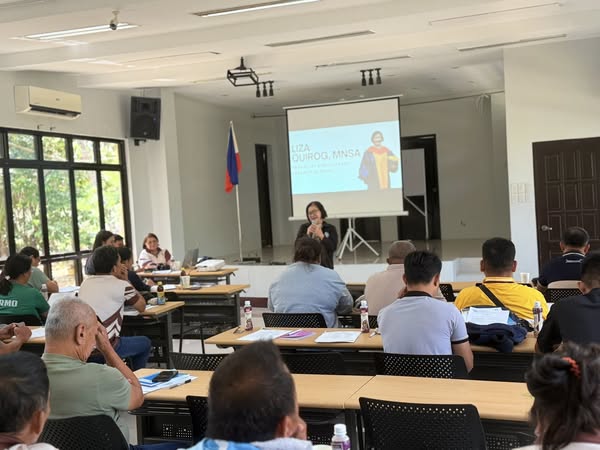Strengthening FARMCs in Bohol for Sustainable Fisheries

The Fisheries and Aquatic Resource Management Councils (FARMCs) in the province of Bohol must be strengthened to increase marine and freshwater fish production, which would lead to higher incomes and a more sufficient food supply. As part of this initiative, consultations and summits have been conducted regularly.
Provincial Agriculturist Liza M. Quirog, in her inspirational message during the FARMC Consultation/Summit held last July 4, 2025 at the Bureau of Fisheries and Aquatic Resources (BFAR)–Central Visayas Multi-Species Nursery Demo and Training Center in Bentig, Calape, Bohol, expressed appreciation for the spirit of volunteerism shown by FARMC members in the municipalities who are now actively engaged in their roles.
Provincial Agriculturist Quirog emphasized the importance of strengthening FARMCs through close collaboration with local officials. She also encouraged the public to raise their concerns regarding marine and freshwater care and development through the barangay councils and FARMCs, so that appropriate policies may be formulated for the benefit of all.
She also highlighted the current challenges facing the fisheries sector, such as the decline in fish catch and the increasing incidence of poverty due to loss of income and livelihood.
The FARMC in the Philippines was established through Executive Order No. 240 on April 28, 1995, to involve local fisherfolk and resource users in the planning and implementation of policies for the management, conservation, development, and protection of fisheries and aquatic resources. Government agencies are mandated to provide technical assistance, while law enforcement agencies are expected to help in the enforcement of environmental laws.
The functions and duties of FARMCs include: prepare and recommend fisheries and aquatic resource management policies and plans based on scientific assessments and bio-economic data, and integrate these plans into the broader Local Development Plan; recommend guidelines to local government units and specialized agencies for project development, implementation, and issuance of permits and licences; evaluate fisheries-related projects and applications prior to approval; and ensure resource use limits and controls are effectively implemented.
The topics being discussed during the consultation/summit were: FishCore Project Overview by Pamela Sullano, Assistant Coordinator; I-Fit Result in Fishery Management Area 9 (FMA9): Key Findings and Future Directions by Albert Simbajon,OIC-MCS; Overview of the Harvest Strategy in FMA9 by Joanne Garcia, NSAP Project Leader; FARMC’s Legal Framework (Duties and Responsibilities) by Joel Lutao, OIC-Fisherfolk Operation; and How to access Budyong , FARMC ICT Social Media-Based Portal.
The event was attended by FARMC chairpersons, secretaries, and treasurers, along with municipal councilors who chair the Sangguniang Bayan Committee on Agriculture in 17 municipalities under FMA9 facing Mindanao. These municipalities include: Panglao, Dauis, Baclayon, Alburquerque, Loay, Lila, Dimiao, Garcia Hernandez, Carlos P. Garcia, Valencia, Jagna, Duero, Guindulman, Anda, Candijay, Mabini, and Ubay.
Mary Queen Atup, Head of the Fishery Division at the Office of the Provincial Agriculturist (OPA), explained that the summit specifically focused on the municipalities under FMA9 that are set to benefit from FishCore projects aimed at improving fisheries management and enhancing production value. She added that the municipalities under FMA10—namely Tagbilaran City, Cortes, Maribojoc, Loon, Calape, Tubigon, Clarin, Inabanga, Buenavista, Getafe, Talibon, Trinidad, and Bien Unido—will also be given equal attention in future engagements.
The Fisheries Management Area (FMA) approach was established to encourage coastal local government units to serve as fisheries managers and take on shared responsibilities. This system promotes positive changes in the conservation and sustainable management of fishery resources, including Science-Based Management, Local Involvement, Sustainable Livelihoods, Ecosystem-Based Approaches, Participatory Governance, and a Transparent Framework. By Atoy Cosap